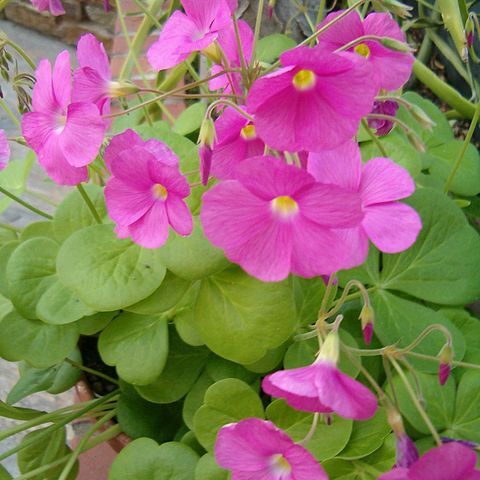Stemless. Plant more or less pubescent or villose, sometimes with short capitate hairs admixed. Bulb ovoid, attenuate, or lanceolate in outline, up to 4.5 cm long, producing a contractile root; tunics smooth, brown. Leaves basal, petiolate; leaflets suborbicular or very broadly obcordate, tapering cuneately to the base, lightly incised or sometimes almost entire, 1-5 cm long, 1.2-5 cm broad, rather leathery, glabrous or sparsely pilose above, more densely so and sometimes purple below, ciliate. Peduncle 3-12-fld., 10-25 cm long, usually at least twice as long as the leaves; bracts linear, 7-9 mm long, ecallose; pedicels usually 1-3 cm long. Sepals lanceolate or linear-lanceolate, 0.6-1.1 cm long, ecallose. Corolla pink, up to 2.5 cm long, with a short widely funnel-shaped greenish-yellow tube; petals obliquely cuneate, attenuate at the base, rounded at the apex, up to 1.2 cm broad. Filaments the longest 8-9 mm long, pubescent, sometimes with glandular hairs on the upper part, edentate. Ovary more or less pubescent on the upper part, the chambers 5-ovuled; styles pubescent below, glandular-pilose above. Seeds with thin endosperm, the embryo green.
Herbs perennial, acaulous, rhizomes present <vertical, slender or thickened, sparsely scaly>, stolons absent, bulbs solitary, <ovate, 2–4 cm>; bulb scales 5-nerved. Leaves basal, <rarely absent at flowering>; petiole (4–)6–16 cm, <densely glandular-puberulent>; leaflets 3, green to purplish abaxially, green adaxially, obcordate, (12–)30–60 mm, lobed 1/6–1/3 length, <lobes apically convex, often fleshy>, surfaces densely glandular-puberulent, oxalate deposits absent. Inflorescences umbelliform cymes, 4–12-flowered; scapes 15–20 cm, densely glandular-puberulent. Flowers heterostylous; sepal apices without tubercles; petals greenish yellow basally, pink to deep rose pink or red distally, 15–20 mm. Capsules not seen.
Acaulescent geophyte, up to 0.03 m high. Bulbs ovoid to lanceolate, smooth, brown. Leaves basally congested, trifoliolate, leaflets suborbicular-obcordate. Peduncles 3-12-flowered. Flowers pink with greenish tube. Sepals without apical calli. Flowering time Mar.-May.
Acaulescent geophyte. Leaves trifoliolate, leaflets suborbicular-obcordate, leathery. Flowers 3-12 per peduncle, pink with greenish tube.

